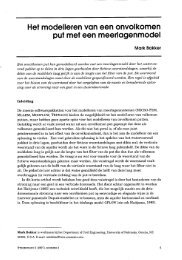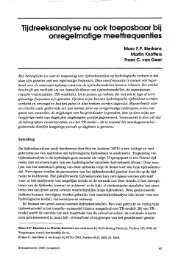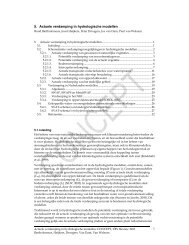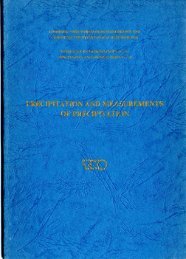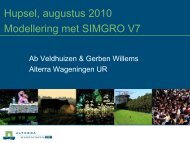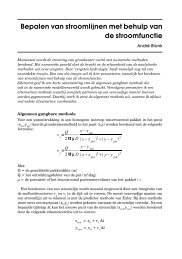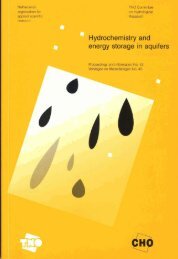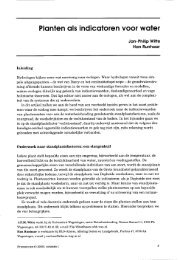Hydro-ecological relations in the Delta Waters
Hydro-ecological relations in the Delta Waters
Hydro-ecological relations in the Delta Waters
Create successful ePaper yourself
Turn your PDF publications into a flip-book with our unique Google optimized e-Paper software.
model calculations reveal that a nitrogen load<strong>in</strong>g of approbimately<br />
-2 -1<br />
10 g W m y or more unwuples <strong>the</strong> eutr@hiulti@n controll<strong>in</strong>g<br />
processes (Qe Vries, et al, 1988).<br />
-2 -1<br />
In <strong>the</strong> Veerse Meer lagoon, experienc<strong>in</strong>g a N-load of 34 g m y and<br />
haa<strong>in</strong>g a long residence time of <strong>the</strong> water, permanent stratifloation<br />
ma<strong>in</strong>ly <strong>in</strong> <strong>the</strong> eastern section and dear water dur<strong>in</strong>g considerable parts<br />
of <strong>the</strong> year, obvionsly, <strong>the</strong> chlorophyl concentration cmot be<br />
controlled by <strong>the</strong> bottom fauna, although a fluctuat<strong>in</strong>g but substantfal<br />
benthic biomass is available.<br />
In <strong>the</strong> recent literature (Benkema and Cadee, 1986; Cadee. 1956a. h;<br />
Cadea and Hegeman, 1966; Nelisseg and Steffels, 1988) a number of<br />
biologi~al effects of <strong>in</strong>creas<strong>in</strong>g eutrophioatbn have been mentioned for<br />
<strong>the</strong> Dutch ccoastal waters and <strong>the</strong> western Wadden Sea: (1) <strong>in</strong>creas<strong>in</strong>g<br />
primary prodwtivn; (2) dom<strong>in</strong>ance of flagellates cwer diaroms; (3)<br />
<strong>in</strong>crw<strong>in</strong>g biomass of benthic macro-fauna; (4) <strong>in</strong>creas<strong>in</strong>g catches<br />
tbimass 7) of demersal fish and shr-S. It ia beymd <strong>the</strong> diwcussibn<br />
of this paper whe<strong>the</strong>r or ~ o<strong>the</strong>se t effects of euthropicatlon are proven<br />
~ausnal facts or jusr assumed tendencies. The question arises whe<strong>the</strong>r<br />
<strong>the</strong> cor<strong>relations</strong> menrfoned for Dutch coaxtal waters can dso be<br />
revealed for <strong>the</strong> estnaries and lagoons <strong>in</strong> <strong>the</strong> Sauth-West Netharlaads.<br />
The answer is negative, for several reasons: (1) long terms series.<br />
6uch as published for <strong>the</strong> Wadden Sea by Beokema and Cadee. 1987, are<br />
not available for <strong>the</strong> Oosterscfielde and Weaterschelde esruarieti; (2)<br />
any possible trend <strong>in</strong> eutrophication of <strong>the</strong> <strong>Delta</strong> estuaries has been<br />
obscured (except for <strong>the</strong> Westerscbelde) by <strong>the</strong> ==cation of <strong>the</strong> <strong>Delta</strong><br />
Wsrks, changtng <strong>the</strong> hgdrography of <strong>the</strong> area drastically. The Veerse<br />
Neer and Grevel<strong>in</strong>gen have <strong>the</strong>ir om euthraphicatipn story, start<strong>in</strong>g<br />
respectively <strong>in</strong> 1961 and 1971 when <strong>the</strong> bas<strong>in</strong>s were cloeed off from, <strong>the</strong><br />
sea (cf. Pig. l).<br />
In Figure 6 a restricted dataset on <strong>the</strong> occurrence of <strong>the</strong> flagellate<br />
Phaeucgstls poucharii <strong>in</strong> <strong>the</strong> weecerh part of <strong>the</strong> Oasterschelde eahtary<br />
is compared with data fro= <strong>the</strong> western Wadden Sea. The Wadden Sea data<br />
reveal. a telacian between <strong>in</strong>creas<strong>in</strong>g eutropbicetion and <strong>in</strong>creas<strong>in</strong>g<br />
<strong>in</strong>cidence of Phaeocystis blooms. The Oosterscbelde data show a





